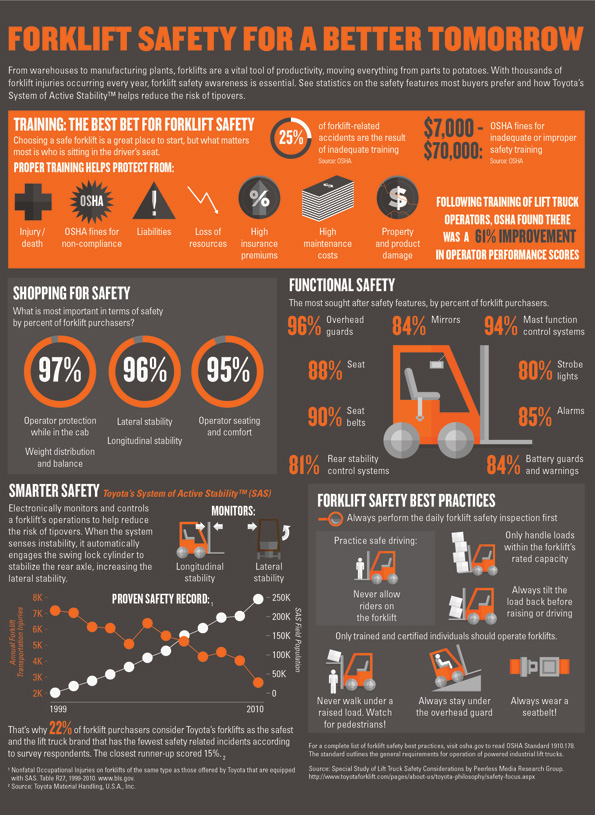Let's Talk Forklift Safety
Insights
6.23.14
I saw some really good posts on forklift safety last week and want to share them below. Much like fall-protection and struck-bys in construction, the distribution and manufacturing employer cannot focus too much on forklift and pallet jack safety and compliance. Although related, strict compliance with the OSHA standards will not guarantee no accidents and well trained operators will not protect one from citations for missing a daily inspection, inadequate evaluation of an operator for a particular machine, or for failure to retrain an operator after an accident. The wise employer always thinks about both parallel tracks ... "safety" and "compliance." So in honor of June 10 National Forklift safety Day, enjoy ....
Ask the Experts: A Q&A About Forklift Safety
Forklift Safety Day was June 10, but just because it’s over doesn’t mean we should stop thinking about and promoting safety around lift trucks, forklifts and other industrial trucks.
Jun 18, 2014 Sandy Smith
Forklifts and Pedestrians Do Not Mix! National Forklift Safety Day, sponsored by the Industrial Truck Association, served as a focal point for manufacturers to highlight the safe use of forklifts and the importance of operator training. The day provided an opportunity for the industry to educate customers, policymakers and the administration on forklift operating safety practices.
While National Forklift Safety Day created greater awareness of safe practices and encouraged safer behavior, we have to ensure that the safety message is shared 365 days a year.
In this Q&A, Chuck Pascarelli, president of sales and marketing, Americas, for Yale Materials Handling Corp., and Paul Laroia, vice president of aftermarket for Hyster Co., answer my questions about Forklift Safety. What I learned is that in the case of forklift safety, oftentimes the manufacturers also are the experts.
Sandy Smith, EHS Today (SS): What should a written forklift safety policy or program include?
Paul Laroia, Hyster Co. (PL): Regardless of the type of forklift being used, training, application knowledge and proper truck maintenance are three of the most critical factors in maintaining a safe work environment.
- Training – Companies must ensure operators receive training on the equipment they will be operating; specifically, that they have read and fully comprehend the operator manual and are aware of the warning labels on the truck.
- Application knowledge – To uphold safety, operators must be very familiar with and thoroughly understand the specific application in which they are working.
- Proper truck maintenance – Routine maintenance helps reduce not only the number of needed repairs but also the risk of accidents that could cause injuries.
Operator training is critical to overall lift truck safety as 70 percent of all industrial accidents are operator-induced, according to the National Safety Council. OSHA estimates that effective training may reduce the accident rate by 25-30 percent, and that following training of lift truck operators, there is a 61 percent improvement in operator performance scores.
Chuck Pascarelli, Yale Materials Handling Corp. (CP): Per OSHA regulations, every lift truck safety program must include operator training, evaluation and certification. It’s critical that operators understand the fundamentals of not only the lift truck equipment they will be operating, but also their specific operating environment.
At Yale, we [offer a] Handle with Care Operator Training Program [that] covers all five lift truck classes, and contains everything needed to conduct the classroom component of an OSHA-compliant operator training program including:
- Instructor guide
- Class-specific tests
- Operating manual
- Course completion certificates
- Authorized wallet cards
SS: What are the key elements of a forklift safety training program for operators? Are there aspects of training that are overlooked? What does OSHA require?
CP: Key elements of a lift truck safety training program, as required by OSHA, encompass specific aspects of the lift truck including warnings, capacity, stability and controls, as well as workplace topics such as surface conditions, pedestrian traffic, hazardous locations and load analysis.
CONTINUE READING AT EHS MAGAZINE.
Another fine piece from EHS Today Magazine:

READ THE ACCOMPANYING ARTICLE AT EHS TODAY.
Also, Toyota Forklifts has good information and took the time to contact me about the infograph above. check them at: http://www.toyotaforklift.com/
EHS Today is also promoting a June 25 Webinar on forklift safety: The Top Ten Enemies of Forklift Safety In Your Operation
Wed, June 25, 2:00pm EDT
Event Type - Live Webinar
Cost - FREE
Description - Under the control of poorly skilled operators, forklifts can turn into weapons. Unfortunately, many workers think these vehicles are the industrial equivalent of cars. That lack of respect for the power a forklift operator wields is why this equipment is involved in OSHA’s most frequent safety violations.
Jim Shephard has seen the aftermath of those mistakes over the course of his 30 years in the material handling industry. Now as an industrial trainer, he devotes his time to identifying and correcting those problems. During this webcast, he will identify the top ten mistakes made with forklifts and offer strategies for correcting them and replacing them with best practices.
This program is designed so operators and their managers can help each other make a significant contribution to their company’s safety and productivity records.
Speaker:
Jim Shephard is president of Shephard’s Industrial Training Systems, Inc., Memphis, TN. After a four-year tour of duty in the United States Navy serving in Vietnam, Shephard was a real estate broker then owned and operated a John Deere Dealership. He eventually accepted a position as a Sales Representative for a Caterpillar Dealership in their Powered Industrial Truck Division. For his success and accomplishments in1982 Jim was recognized by Caterpillar Tractor and featured in Caterpillar’s worldwide Dealer magazine for his sales efforts, marketing strategies and strong values toward customer service. In 1984 Shephard took the Regional Managers position for Long Reach and Rol-Lift Manufacturing Companies (a manufacturer of special material handling attachments for heavy equipment) a subsidiary of Anderson Clayton Company. He provided Consulting Services to 250 plus dealers. Primary duties were to assist clients in obtaining special material handling equipment that would increase productivity and improve safety. In 1986 he founded Shephard’s Industrial Training Systems, Inc., which became one of the first, if not the first, consulting companies to focus its resources on developing and implementing customized operator training programs for industries. Since then he has focused his company’s efforts on providing “Site and Equipment-Specific Operator Training and Certification Programs.” His company hasexpanded its customer base throughout North America and the Caribbean in industries such as: Paper, Forestry, Steel, Aluminum, Lumber, Logistics, Landfills, Chemical, Plastics, Equipment Manufacturers, Maritime, US Government, and more. In 1991 the Occupational Safety and Health Administration in Washington, D.C. invited Shephard to assist in rewriting the Powered Industrial Truck Operator Training Standards for General Industries. He completed this task in 1999, when the new regulations were passed into law.
Related People
-
- Howard A. Mavity
- Partner
